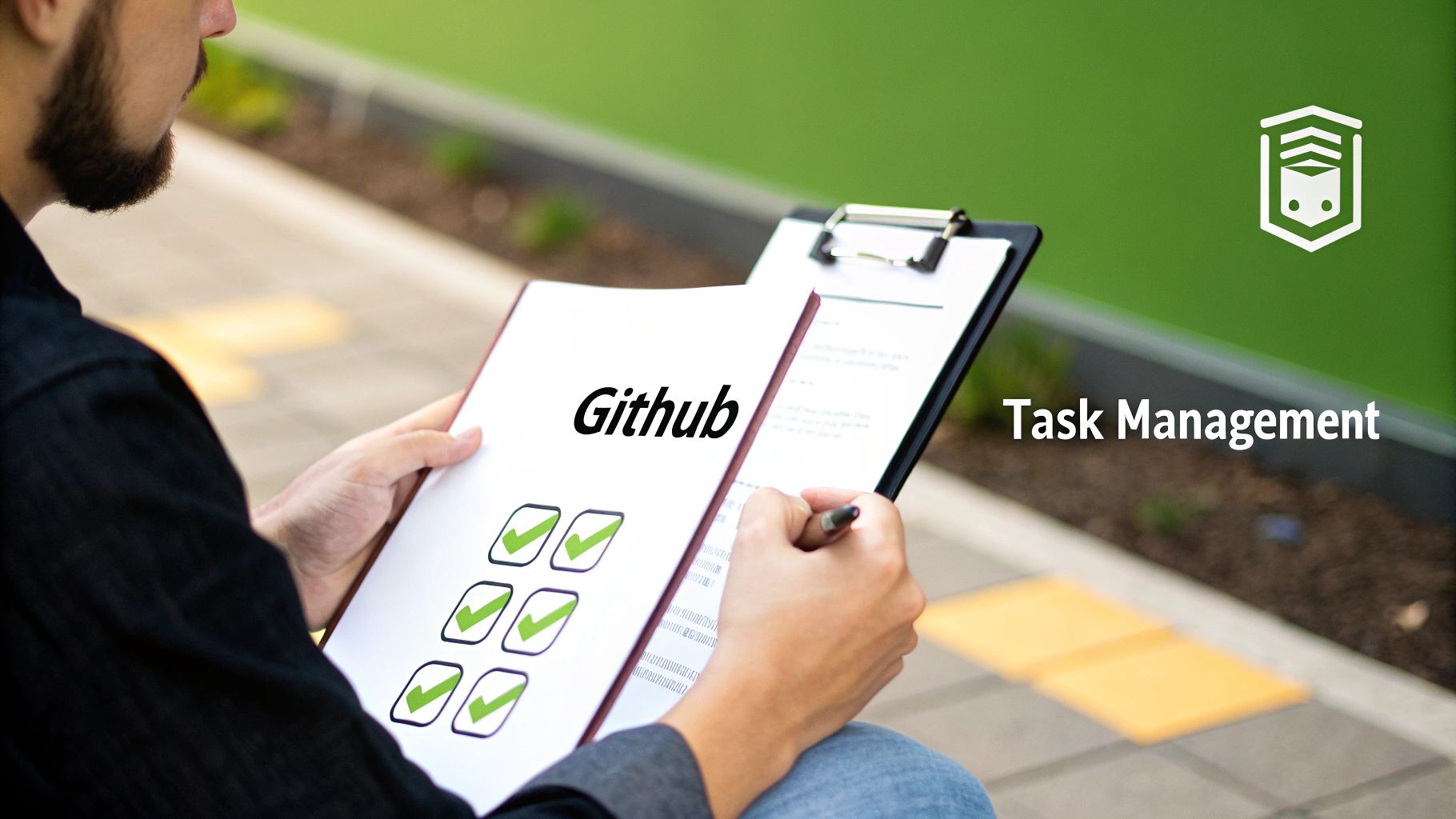Boost Dev Workflow with github md checklist
Mastering GitHub MD Checklist Fundamentals

GitHub MD checklists are interactive to-do lists that make team collaboration simpler and more effective. They let you track tasks right in your project documentation, helping teams work together smoothly. But there's more to them than just making lists - let's explore how to use these checklists effectively.
Understanding the Basic Syntax
Creating GitHub MD checklists is straightforward. Use either - or * followed by square brackets to make checklist items:
- [ ] Task 1creates an empty checkbox- [x] Task 2creates a checked box
One of the best features is automatic status updates - when you link a checklist item to an issue, it gets checked off automatically when that issue is closed. This feature has been helping teams track progress since 2013. Learn more about making the most of checklists here: Discover more insights about GitHub markdown checklists.
Structuring Checklists for Clarity
Good organization makes checklists more useful. Group related tasks under clear headings and keep descriptions short and specific. This helps everyone understand what needs to be done and makes complex projects easier to manage.
Using Checklists in Issues and Pull Requests
Checklists work especially well in GitHub issues and pull requests. In issues, they help break big tasks into smaller steps. In pull requests, they give reviewers a clear list of things to check, which helps maintain code quality standards.
By mastering these basics, your team can track work more clearly and get more done. Simple checklists become powerful tools for keeping projects on track and delivering quality results. Once you're comfortable with these fundamentals, you can explore more advanced ways to use them.
Creating Dynamic Checklists That Drive Results

Want to take your GitHub checklists to the next level? Let's explore how smart checklist design can make your project tracking more effective. Good checklists help teams stay organized and focused on what matters.
Let's explore how to create checklists that adapt and grow with your projects while staying clear and useful.
Structuring Tasks for Maximum Impact
The best checklists serve as project roadmaps, not just random lists. Start by grouping similar tasks under clear headings. For a website launch, you might have sections like "Content Prep", "Tech Setup", and "Marketing Tasks". This helps team members quickly understand the workflow.
Within each section, arrange tasks in a logical order - tackle foundational items before moving to specific details. This natural progression keeps everyone moving in the right direction.
Establishing Clear Hierarchies With Sub-Issues
For complex projects, break down big tasks into smaller chunks using sub-issues in GitHub. This nested approach lets you track individual components while seeing how they connect to the larger goals. A "Content Prep" section could include sub-tasks like "Write Blog Post", "Edit Images", and "Final Review".
Implementing Effective Naming Conventions
Use clear, action-focused names for checklist items. Instead of "Website Design", write "Create Homepage Mockup". Add useful tags like [BUG] or [FEATURE] to help with sorting and reporting later.
Here's a quick comparison of different checklist approaches:
| Syntax Type | Example | Use Case | Benefits | |-------------|---------|-----------|----------| | Basic Tasks | - [ ] Task 1 | Simple projects | Easy to create and update | | Nested Tasks | - [ ] Main Task<br> - [ ] Subtask | Complex workflows | Shows task relationships | | Tagged Tasks | - [ ] [BUG] Fix login | Issue tracking | Better organization | | Numbered Tasks | 1. [ ] First step | Sequential work | Clear order |
Contextual Organization Boosts Productivity
Smart teams customize their checklists based on the specific project needs. A code review checklist looks very different from a product launch checklist. Keep only relevant items and skip anything that doesn't directly help the current goal. This focused approach helps teams work more efficiently and stay on track.
Automating Your Way to Checklist Mastery

Managing checklists by hand can eat up a lot of time. By using automation with your GitHub markdown checklists, you can turn them into smart tools that update themselves. This frees up your time and keeps your docs in sync with project progress. Many top dev teams already use GitHub's API and integrations to automate their checklists.
Using GitHub's API for Automation
The GitHub API gives you powerful ways to work with your repos, issues and pull requests. You can use it to automatically update GitHub MD checklists when things happen in your project. For example, when someone closes an issue linked to a checklist item, the API can check it off automatically. You can also build custom integrations that update checklists based on other events like successful builds or merged code. This cuts down on manual work and keeps docs accurate.
Connecting to Project Management Tools
GitHub works smoothly with many project management platforms. These connections help automate your GitHub MD checklist workflows even more. When someone completes a task in your project tool, it can automatically update the matching checklist item in GitHub. This gives everyone a clear view of project status across different tools. The Pull Checklist tool on GitHub Marketplace adds more automation options like conditional checks and reporting.
Keeping Human Oversight
While automation helps a lot, you still need people checking things over. This ensures everything stays accurate and can be adjusted when needed. Think of automated updates as helpful tools, not complete replacements for human review. Teams should regularly look over automatically updated checklists to catch any issues automation might miss. This balanced approach keeps data accurate while saving time. It also helps team members share responsibility.
The move to interactive tools has made a real difference. Millions of markdown files on GitHub now use checklists. Research into how people use markdown has helped improve features and speed, showing how docs have evolved from static text to collaboration tools. Learn more: See detailed usage stats. Finding the right mix of automation and human input will help your team work better and get more done.
Improving Pull Request Workflows

Good pull requests (PRs) are key for successful code review and team collaboration. GitHub markdown checklists help make reviews organized and productive. Teams can use them to standardize their process, follow consistent practices, and catch issues early.
Making Reviews More Effective
Adding a checklist to PR templates ensures reviewers evaluate the same important aspects each time. For example, they can systematically verify test coverage, coding standards, and security concerns. This focused approach speeds up reviews and improves their quality.
Setting Clear Standards
PR checklists help teams follow coding best practices and project requirements. By listing key criteria directly in the PR, developers at all experience levels can maintain consistent code quality. Clear guidelines visible to everyone reduce confusion and keep code maintainable.
Preventing Future Problems
Catching issues during code review with checklists prevents technical debt from building up. Fixing problems before they reach production is much cheaper and easier. This proactive approach creates more stable, maintainable code over time.
Practical Checklist Examples
Many development teams create specific GitHub markdown checklist templates for different PR types. Here's a breakdown of common templates:
| PR Type | Template Items | Required Checks | |---|---|---| | Feature Implementation | - Unit tests implemented <br> - Integration tests passed <br> - Documentation updated | - Code review by two senior developers <br> - All tests passing | | Bug Fix | - Root cause identified <br> - Regression tests added <br> - Issue documented | - Code review by one developer <br> - Verification in staging environment | | Refactoring | - Performance benchmarks <br> - No functional changes <br> - Code complexity analysis | - Code review by one developer <br> - Automated code style checks |
You can enhance these templates using tools like Pull Checklist from the GitHub Marketplace. It enables conditional checks that show only relevant items based on the PR context. This helps teams optimize their process by removing unnecessary steps. Using PR checklists results in better code quality, smoother workflows, and continuous process improvements.
Building Team Collaboration That Works
Team coordination is essential for delivering successful projects. Using GitHub markdown checklists can significantly improve how teams work together, coordinate tasks, and track progress. Rather than just serving as task lists, they create shared project visibility and clarify each person's role.
Creating Templates That Scale
For growing development teams, having consistent processes becomes critical. Well-designed checklist templates ensure everyone follows standardized workflows, whether they're new to the project or have been involved since day one. This uniformity removes confusion and helps teams work more efficiently. Common templates might include:
- Root cause identification for bug fixes
- Test coverage requirements
- Documentation standards
- Code review steps
Establishing Effective Workflow Conventions
Teams need clear guidelines for using checklists effectively. This includes:
- Using specific, action-oriented task names
- Setting task detail requirements
- Defining integrations with project tools
- Following consistent naming patterns
For example, write "Add User Authentication Method" instead of vague items like "Security Update." Connecting checklists to project management tools like Jira helps automate status tracking.
Fostering a Culture of Systematic Progress Tracking
When teams fully adopt checklist-driven workflows, it creates transparency and accountability. Everyone can see project status at a glance, enabling proactive communication about potential issues before they become problems. The systematic approach provides valuable data for:
- Identifying process bottlenecks
- Tracking completion rates
- Measuring team velocity
- Planning future improvements
By making checklists a core part of their workflow, development teams build an environment focused on clear communication and consistent delivery of high-quality work.
Power User Tips That Actually Matter
Want to get more out of GitHub MD checklists? These advanced techniques, used by experienced developers, will help you work more efficiently and make the most of this powerful feature.
Keyboard Shortcuts for Efficiency
Speed up your workflow with keyboard shortcuts when working with GitHub MD checklists. Press the spacebar to quickly check/uncheck items. Use the Tab key to create nested lists by indenting checklist items - perfect for organizing complex projects without taking your hands off the keyboard.
Custom Styling With HTML and CSS
While markdown is great for simplicity, sometimes you need more control over how your checklists look. You can add basic HTML and CSS directly in your markdown files for custom styling. For example, use <span style="color:red;"> to highlight key items. Just remember - too much styling can make your markdown harder to read, so keep it simple.
Integrating With External Tools
Connect your GitHub MD checklists with project management tools for better workflow. Pull Checklist offers features like conditional checklist items and automated updates. This means your checklist can update automatically based on project status in other tools.
Leveraging Nested Checklists for Complex Projects
Break down big tasks into smaller, manageable steps using nested checklists. For example, a top-level item like "Deploy New Version" might include sub-items:
- Update Server Configuration
- Run Database Migrations
- Test in Staging Environment
This structure gives you a clear roadmap for complex work.
Regularly Reviewing and Refining Your Checklists
Even great checklists need updates to stay useful. Schedule short team meetings every few weeks to review which checklist items are working well and what needs changes. This helps keep your checklists relevant and effective as your project grows.
Want to improve your code review process? Pull Checklist helps teams enforce best practices and maintain consistent code quality through automation. Check it out to level up your GitHub pull requests.
